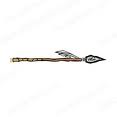 Arrow – Here are the different meanings of the arrow symbol in native American art.Arrowhead – Alertness. Arrow – Here are the different meanings of the arrow symbol in native American art.Arrowhead – Alertness.
Arrow Pointing Right – Protection.
Arrow Pointing Left – Warding of Evil |
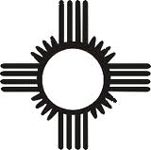 Sun Symbol (also known as the Zia symbol)- The sun symbol often means “Earth Guardian in Day,” and it can also represent Healing Energy. The sun symbol is also recognized as a giver of life and a provider of warmth. Sun Symbol (also known as the Zia symbol)- The sun symbol often means “Earth Guardian in Day,” and it can also represent Healing Energy. The sun symbol is also recognized as a giver of life and a provider of warmth. |
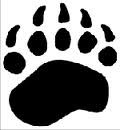 Bear Track Bear Track
Native Americans often view the bear track symbol as a good omen. |
Thunderbird
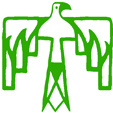 A mythical Native American creature that dominates all natural activities, the Thunderbird symbolizes divine dominion, protection, provision, strength, authority, and indomitable spirit. This cross-cultural symbol is found among the Plains Indians and the tribes in the Pacific Northwest and Northeast, though its meaning may vary across different groups. Some tribes considered the Thunderbird to be a sign of war, and the sound of thunder in the clouds was believed to be a prophecy of victory in tribal wars if ritual dances and ceremonies were performed. Others looked at the Thunderbird as a solar animal that controlled the dawn of day and night by opening and closing its eyes made of the Sun. A mythical Native American creature that dominates all natural activities, the Thunderbird symbolizes divine dominion, protection, provision, strength, authority, and indomitable spirit. This cross-cultural symbol is found among the Plains Indians and the tribes in the Pacific Northwest and Northeast, though its meaning may vary across different groups. Some tribes considered the Thunderbird to be a sign of war, and the sound of thunder in the clouds was believed to be a prophecy of victory in tribal wars if ritual dances and ceremonies were performed. Others looked at the Thunderbird as a solar animal that controlled the dawn of day and night by opening and closing its eyes made of the Sun.
|
 Morning Star Morning Star
Honoured as Kachina by most Pueblo tribes, the morning star is a sign of courage and purity of spirit. |
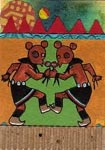 Clown – The clown symbol symbolizes well-being or joyfulness, good times & it can also symbolize the harvest. The most popular clown is the popular “Mud Head.” Clown – The clown symbol symbolizes well-being or joyfulness, good times & it can also symbolize the harvest. The most popular clown is the popular “Mud Head.” |
 Navajo Yeii Spirit – A spirit the Navajo considers to be a mediator between man and his creator. Yeiis control natural forces, such as day and night, rain, wind, sun & others. A very exceptional kind of Yeii is the Yei’bi’chai, grandparent spirit or “talking God” who can speak to a man, teaching him how to live in harmony with all living things by following some simple rules of behaviour to conserve and use well only the things he needs to survive. A symbol of the harmony achieved is the “Rainbow Man,” a Yeii commanding the rainbow, giving beauty to all those in harmony. Navajo Yeii Spirit – A spirit the Navajo considers to be a mediator between man and his creator. Yeiis control natural forces, such as day and night, rain, wind, sun & others. A very exceptional kind of Yeii is the Yei’bi’chai, grandparent spirit or “talking God” who can speak to a man, teaching him how to live in harmony with all living things by following some simple rules of behaviour to conserve and use well only the things he needs to survive. A symbol of the harmony achieved is the “Rainbow Man,” a Yeii commanding the rainbow, giving beauty to all those in harmony. |
 The four ages of man are childhood, youth, middle age and old age. The sign is used with this meaning by some Indian tribes in the southwestern USA. The four ages of man are childhood, youth, middle age and old age. The sign is used with this meaning by some Indian tribes in the southwestern USA. |
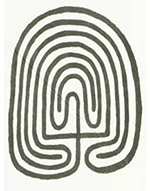 Hopi Maze or Mother Earth Symbol Hopi Maze or Mother Earth Symbol
– This is an important symbol of the Hopi people and many other Native American tribes. The Maze represents the maze of life, that is, the obstacles and challenges one must overcome to evolve spiritually and become one with the divine power. It is also known as the Mother Earth symbol and signifies the deep bond between Mother Earth and us, her children. The center line symbolizes the child (a metaphor for the beginning of our philosophical journey), and the surrounding maze represents the mother’s (Earth’s or Nature’s) support that is always available to guide the child through life. The Mother Earth/Maze symbol identifies all that is sacred in nature and reminds man to revere and be thankful for it. |
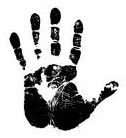 Hand Print – Symbol of a human’s life, achievements, and legacy, the creative spirit, channelled energy. Hand Print – Symbol of a human’s life, achievements, and legacy, the creative spirit, channelled energy.
|
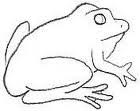 Frog Symbol – The symbol of a frog in native American terms often means renewal and fertility, and it can also mean the arrival of springtime. Frog Symbol – The symbol of a frog in native American terms often means renewal and fertility, and it can also mean the arrival of springtime. |
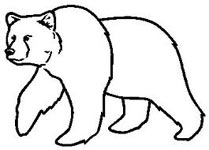 Bear – The Bear symbol is known as a protector. The symbol of the bear denotes strength and also leadership. The bear is frequently mentioned as the “first helper” in creation & emergence stories. Bear – The Bear symbol is known as a protector. The symbol of the bear denotes strength and also leadership. The bear is frequently mentioned as the “first helper” in creation & emergence stories. |
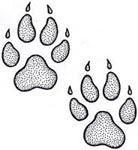 Wolf Tracks – Wolf tracks symbolize “direction” and leadership. Wolf Tracks – Wolf tracks symbolize “direction” and leadership. |
 Deer Symbol – The deer symbolizes protection of one`s family, and the deer symbol can also symbolize speed. Deer Symbol – The deer symbolizes protection of one`s family, and the deer symbol can also symbolize speed. |
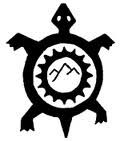 Turtle – The turtle symbolizes long life, and it also annoys the coyote. The turtle is slow but steady. Turtle – The turtle symbolizes long life, and it also annoys the coyote. The turtle is slow but steady. |
 Eagle – Symbolizes courage, strength, wisdom, and a special religious connection due to his association with spirits and visions. Eagle – Symbolizes courage, strength, wisdom, and a special religious connection due to his association with spirits and visions. |
 Owl – Symbolizes nighttime and being wise. It also means good hunting skills. Owl – Symbolizes nighttime and being wise. It also means good hunting skills. |
 Raven – In the Native American symbolic lore, Raven is the bearer of magic and light, the bringer of cosmic messages, and the keeper of secrets. It is considered symbolic of transformation, knowledge, and understanding. The tribal holy men called upon the Raven in rituals to clarify visions. The Raven was also believed to have long-distance healing powers.This Native American animal symbol was seen as humanitarian, and many tribes venerated it as a bird of creation. The Raven was also recognized for its high enthusiasm, energy, easy charm, and wisdom and sought after for advice, opinions, and ideas. Raven – In the Native American symbolic lore, Raven is the bearer of magic and light, the bringer of cosmic messages, and the keeper of secrets. It is considered symbolic of transformation, knowledge, and understanding. The tribal holy men called upon the Raven in rituals to clarify visions. The Raven was also believed to have long-distance healing powers.This Native American animal symbol was seen as humanitarian, and many tribes venerated it as a bird of creation. The Raven was also recognized for its high enthusiasm, energy, easy charm, and wisdom and sought after for advice, opinions, and ideas. |
| Feathers – Fanned into a Circle – Related to the Sun and The Creator. |
| Pipe – Used in negotiations of peace and war, to offer sacred tobacco smoke to the four directions, and in a religious ceremony. |
| Saddle Bag – Represents a journey. |
 Deer Tracks – Deer tracks symbolize safety and shelter. Deer Tracks – Deer tracks symbolize safety and shelter. |

 Camp Symbol
Camp Symbol Rain Clouds
Rain Clouds Eagle Symbol
Eagle Symbol Frog Symbol
Frog Symbol Good Prospects Symbol
Good Prospects Symbol Native American Hand Symbol
Native American Hand Symbol Happy Symbol
Happy Symbol Homecoming Symbol
Homecoming Symbol Hummingbird Symbol
Hummingbird Symbol Kokopelli Symbol
Kokopelli Symbol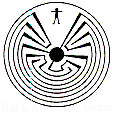 Man in Maze Symbol
Man in Maze Symbol Man In Maze Symbol 2
Man In Maze Symbol 2 Star Symbol
Star Symbol Summer Symbol
Summer Symbol Sun symbol
Sun symbol Twins Symbol
Twins Symbol War Symbol
War Symbol Waterbird Symbol
Waterbird Symbol
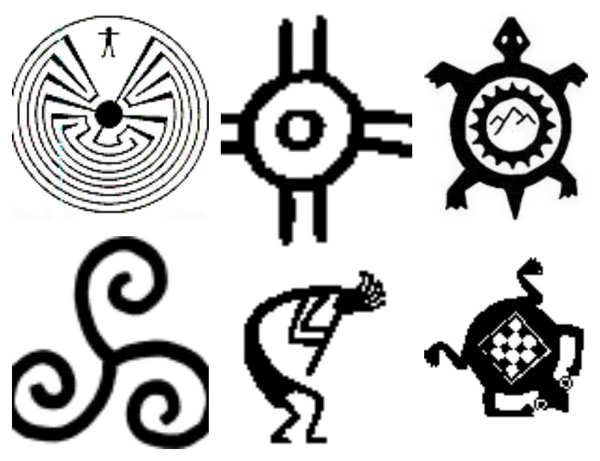
 Arrow – Here are the different meanings of the arrow symbol in native American art.Arrowhead – Alertness.
Arrow – Here are the different meanings of the arrow symbol in native American art.Arrowhead – Alertness. Sun Symbol (also known as the Zia symbol)- The sun symbol often means “Earth Guardian in Day,” and it can also represent Healing Energy. The sun symbol is also recognized as a giver of life and a provider of warmth.
Sun Symbol (also known as the Zia symbol)- The sun symbol often means “Earth Guardian in Day,” and it can also represent Healing Energy. The sun symbol is also recognized as a giver of life and a provider of warmth.
 Bear Track
Bear Track
 Morning Star
Morning Star Clown – The clown symbol symbolizes well-being or joyfulness, good times & it can also symbolize the harvest. The most popular clown is the popular “Mud Head.”
Clown – The clown symbol symbolizes well-being or joyfulness, good times & it can also symbolize the harvest. The most popular clown is the popular “Mud Head.” Navajo Yeii Spirit – A spirit the Navajo considers to be a mediator between man and his creator. Yeiis control natural forces, such as day and night, rain, wind, sun & others. A very exceptional kind of Yeii is the Yei’bi’chai, grandparent spirit or “talking God” who can speak to a man, teaching him how to live in harmony with all living things by following some simple rules of behaviour to conserve and use well only the things he needs to survive. A symbol of the harmony achieved is the “Rainbow Man,” a Yeii commanding the rainbow, giving beauty to all those in harmony.
Navajo Yeii Spirit – A spirit the Navajo considers to be a mediator between man and his creator. Yeiis control natural forces, such as day and night, rain, wind, sun & others. A very exceptional kind of Yeii is the Yei’bi’chai, grandparent spirit or “talking God” who can speak to a man, teaching him how to live in harmony with all living things by following some simple rules of behaviour to conserve and use well only the things he needs to survive. A symbol of the harmony achieved is the “Rainbow Man,” a Yeii commanding the rainbow, giving beauty to all those in harmony. The four ages of man are childhood, youth, middle age and old age. The sign is used with this meaning by some Indian tribes in the southwestern USA.
The four ages of man are childhood, youth, middle age and old age. The sign is used with this meaning by some Indian tribes in the southwestern USA. Hopi Maze or Mother Earth Symbol
Hopi Maze or Mother Earth Symbol Hand Print – Symbol of a human’s life, achievements, and legacy, the creative spirit, channelled energy.
Hand Print – Symbol of a human’s life, achievements, and legacy, the creative spirit, channelled energy. Frog Symbol – The symbol of a frog in native American terms often means renewal and fertility, and it can also mean the arrival of springtime.
Frog Symbol – The symbol of a frog in native American terms often means renewal and fertility, and it can also mean the arrival of springtime. Bear – The Bear symbol is known as a protector. The symbol of the bear denotes strength and also leadership. The bear is frequently mentioned as the “first helper” in creation & emergence stories.
Bear – The Bear symbol is known as a protector. The symbol of the bear denotes strength and also leadership. The bear is frequently mentioned as the “first helper” in creation & emergence stories. Wolf Tracks – Wolf tracks symbolize “direction” and leadership.
Wolf Tracks – Wolf tracks symbolize “direction” and leadership. Deer Symbol – The deer symbolizes protection of one`s family, and the deer symbol can also symbolize speed.
Deer Symbol – The deer symbolizes protection of one`s family, and the deer symbol can also symbolize speed. Turtle – The turtle symbolizes long life, and it also annoys the coyote. The turtle is slow but steady.
Turtle – The turtle symbolizes long life, and it also annoys the coyote. The turtle is slow but steady. Eagle – Symbolizes courage, strength, wisdom, and a special religious connection due to his association with spirits and visions.
Eagle – Symbolizes courage, strength, wisdom, and a special religious connection due to his association with spirits and visions. Owl – Symbolizes nighttime and being wise. It also means good hunting skills.
Owl – Symbolizes nighttime and being wise. It also means good hunting skills. Raven – In the Native American symbolic lore, Raven is the bearer of magic and light, the bringer of cosmic messages, and the keeper of secrets. It is considered symbolic of transformation, knowledge, and understanding. The tribal holy men called upon the Raven in rituals to clarify visions. The Raven was also believed to have long-distance healing powers.This Native American animal symbol was seen as humanitarian, and many tribes venerated it as a bird of creation. The Raven was also recognized for its high enthusiasm, energy, easy charm, and wisdom and sought after for advice, opinions, and ideas.
Raven – In the Native American symbolic lore, Raven is the bearer of magic and light, the bringer of cosmic messages, and the keeper of secrets. It is considered symbolic of transformation, knowledge, and understanding. The tribal holy men called upon the Raven in rituals to clarify visions. The Raven was also believed to have long-distance healing powers.This Native American animal symbol was seen as humanitarian, and many tribes venerated it as a bird of creation. The Raven was also recognized for its high enthusiasm, energy, easy charm, and wisdom and sought after for advice, opinions, and ideas. Deer Tracks – Deer tracks symbolize safety and shelter.
Deer Tracks – Deer tracks symbolize safety and shelter.